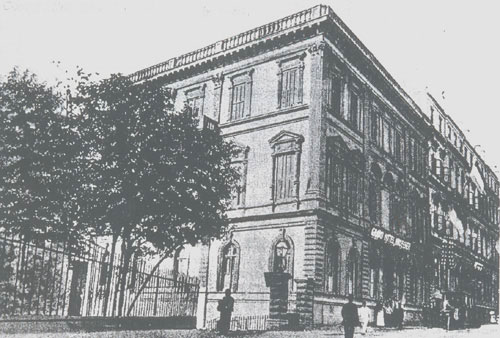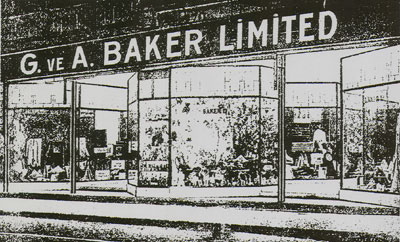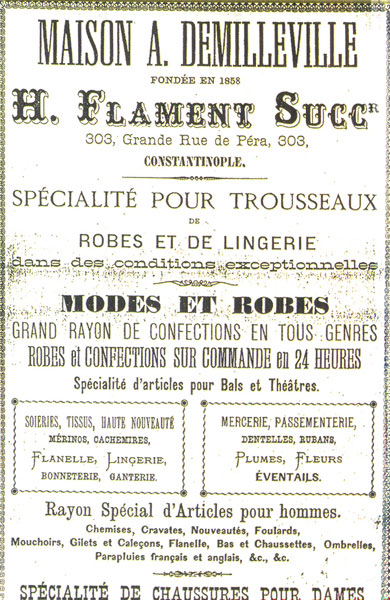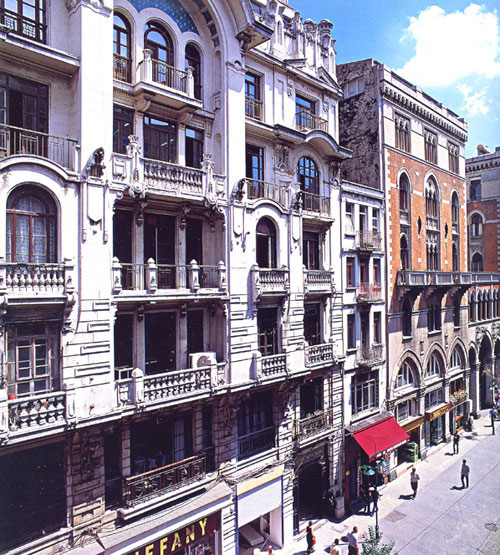p.155
Charles Couteaux
He was a Galata banker who had a very large apartment building on the Grand-Rue de Pera opposite Ağa Camii [Mosque]. This building was occupied by the Legation of the United States of America as well as the family members.
Mavrogordato (there were also those who said Mavrokordato).
This was a very extensive family. Two of the brothers, Atanas Mavrogordato and Theodore Mavrogordato, were Galata Bankers and also involved in all kinds of other business. The large mansion on Su Terazi Sokağı [Street] just before the mansion of Agop Köçeoğlu belonged to the Mavrogordatos. On the death of Mavrogordato, his wife and other family members continued to live there for a time until they eventually sold the mansion. In time, the mansion acquired the name Belle Air Hotel, which was directed by Bogos Kantar [an Armenian name]. In the 1950s it was turned into Santral Han and became the property of İş Bankası [bank].
The Tubini family
Three inter-related families arrived together from Chios; the Numicos, the Tubinis and the Corpis. At the time, all the land to the left of Kabristan Sokağı (today’s Meşrutiyet Caddesi [road]) starting from Şişhane [the quarter by Pera] was covered with graveyards and unoccupied land. The three families bought the entire 9.002 square metres area stretching from Simal Sokağı to the present site of the Pera Palaca Hotel and divided it up into three according to the size of the families. The land from Simai Sokağı to the American embassy belonged to the Nomico brothers, the American consulate section to the Corpi family, and the land adjacent to the American consulate to the Tubini brothers. [the US consulate has moved to a way out location in the recent years for security reasons - history of the former building].
The Nomico family, in common with the Tubinis and Corpis, were money lenders, but in addition they worked as industrialists. Being a large family, the Nomicos had three seperate buildings constructed on the section between Simal Sokağı and the American Embassy. Shortly after their construction was completed, whether because it was their need of money or for some other reason, they put all their places up for rent. The tenants first turned the place into a hotel, section by section, and gave this hotel the name of Grand Hotel Kroecker. Eventually, this hotel closed and the Corpis’ mansion was sold to the United States of America. Until 1937, this building served as the American Embassy. For at that time, as the United States of America did not recognize the Turkish Republic the Embassy remained in Istanbul, and after that date it was moved to Ankara. The final building was the Tubini’s house, which became the Istanbul Club, and when the Istanbul Club moved from there it became the directorate of scientific affairs of the Istanbul Municipality.
The building constructed on the land (9,002 square metres)
bought jointly by the Nomico, Corpi and Tubini families, 1880. The Corpi
family’s building was the Corpi Palace. In 1907, this building became
the American Embassy. In 1937 it became the American Consulate, as it
still is today. The last building was the residence of the Tubini family.
Notes: 1- In this book there are other references, in the following sections, to the Tubini family such as: TUBINIS IN THE BANKS - UNION FONCIERE (1858-1860) Shareholders: Tubini, Corpi, Baltazzi, Y.Zarifi, I.Camondo; BANK OF TURKEY 1858-1860 In the bank administration Bernard Tubini; CREDIT GENERAL OTTOMAN (1868-1899) George Tubini shareholder; BANKERS IN GÜL CAMONDO HANI ( Around 1860 ) at 20 Billur sokak George Tubini & Sons. In a separate book, ‘Türk Bankacılık Tarihi’ [Turkish banking history] by P. Haydar Kazgan, mentions a ‘Junior Tubini’, who operated a furniture store in the Istanbul neighbourhood of Beşiktaş, which in time became famous enough to find customers in Europe.
2- In the book ‘The Princes’ Isles: a guide by John Freely - 2005’, page 82 record the address of a Tubini house on Büyükada [Prinkipo], (no: 66 on Çankaya cad), while the Corpi mansion is recorded on p. 83 at no: 4 Dr. Asaf Derviş çıkmazı, a fashionable island then and now, so clearly these families were wealthy.
p.157
Richard Edwards
He was the pride and joy of the family of English origin who came to Istanbul after the 1854 Crimean War and bought the famous Aslanlı Konağı [mansion with lions] in Bebek [village on the European shore of the Bosphorus].
p.261
Gracie Stores
This store was opened in 1845. Later its name was changed to Grand Bazaar Parisienne. The two story store was located next to the Russian embassy. The jewellery counter was on the upper floor. There was another department on the upper floor which was called ‘Le Bon Ton’. In this section there was a separate counter for jewellery.
One of the oldest arcades of Pera was the Şark Aynalı Çarşısı. In 1850, a very large store by the name of Horlogerie de Francaise opened here. In this store all kinds of watches and clocks as well as gold and jewellery were sold. The owner of the firm was Mr. Gautier.
Magasin de France
This store opened in Dort Yol on the corner of Asmalı Mescit opposite the Hotel d’Angleterre in 1845. In 1860, all the goods were reduced on the grounds that this two-storey store was to be completely decorated. In the store there was a counter for gold and also one for silver.
Baker and Hayden stores
These two partners took the store on the site just after Su Terazi Sokağı where Anadolu Pasajı was to be built. They also had a store at the entrance to Kule Kapısı. It was in fact Hayden who opened both stores single-handedly. In 1854 after the Crimean War, the Baker family emigrating from England went into partnership with this firm.
Charles Couteaux
He was a Galata banker who had a very large apartment building on the Grand-Rue de Pera opposite Ağa Camii [Mosque]. This building was occupied by the Legation of the United States of America as well as the family members.
Mavrogordato (there were also those who said Mavrokordato).
This was a very extensive family. Two of the brothers, Atanas Mavrogordato and Theodore Mavrogordato, were Galata Bankers and also involved in all kinds of other business. The large mansion on Su Terazi Sokağı [Street] just before the mansion of Agop Köçeoğlu belonged to the Mavrogordatos. On the death of Mavrogordato, his wife and other family members continued to live there for a time until they eventually sold the mansion. In time, the mansion acquired the name Belle Air Hotel, which was directed by Bogos Kantar [an Armenian name]. In the 1950s it was turned into Santral Han and became the property of İş Bankası [bank].
The Tubini family
Three inter-related families arrived together from Chios; the Numicos, the Tubinis and the Corpis. At the time, all the land to the left of Kabristan Sokağı (today’s Meşrutiyet Caddesi [road]) starting from Şişhane [the quarter by Pera] was covered with graveyards and unoccupied land. The three families bought the entire 9.002 square metres area stretching from Simal Sokağı to the present site of the Pera Palaca Hotel and divided it up into three according to the size of the families. The land from Simai Sokağı to the American embassy belonged to the Nomico brothers, the American consulate section to the Corpi family, and the land adjacent to the American consulate to the Tubini brothers. [the US consulate has moved to a way out location in the recent years for security reasons - history of the former building].
The Nomico family, in common with the Tubinis and Corpis, were money lenders, but in addition they worked as industrialists. Being a large family, the Nomicos had three seperate buildings constructed on the section between Simal Sokağı and the American Embassy. Shortly after their construction was completed, whether because it was their need of money or for some other reason, they put all their places up for rent. The tenants first turned the place into a hotel, section by section, and gave this hotel the name of Grand Hotel Kroecker. Eventually, this hotel closed and the Corpis’ mansion was sold to the United States of America. Until 1937, this building served as the American Embassy. For at that time, as the United States of America did not recognize the Turkish Republic the Embassy remained in Istanbul, and after that date it was moved to Ankara. The final building was the Tubini’s house, which became the Istanbul Club, and when the Istanbul Club moved from there it became the directorate of scientific affairs of the Istanbul Municipality.
 |
Notes: 1- In this book there are other references, in the following sections, to the Tubini family such as: TUBINIS IN THE BANKS - UNION FONCIERE (1858-1860) Shareholders: Tubini, Corpi, Baltazzi, Y.Zarifi, I.Camondo; BANK OF TURKEY 1858-1860 In the bank administration Bernard Tubini; CREDIT GENERAL OTTOMAN (1868-1899) George Tubini shareholder; BANKERS IN GÜL CAMONDO HANI ( Around 1860 ) at 20 Billur sokak George Tubini & Sons. In a separate book, ‘Türk Bankacılık Tarihi’ [Turkish banking history] by P. Haydar Kazgan, mentions a ‘Junior Tubini’, who operated a furniture store in the Istanbul neighbourhood of Beşiktaş, which in time became famous enough to find customers in Europe.
2- In the book ‘The Princes’ Isles: a guide by John Freely - 2005’, page 82 record the address of a Tubini house on Büyükada [Prinkipo], (no: 66 on Çankaya cad), while the Corpi mansion is recorded on p. 83 at no: 4 Dr. Asaf Derviş çıkmazı, a fashionable island then and now, so clearly these families were wealthy.
p.157
Richard Edwards
He was the pride and joy of the family of English origin who came to Istanbul after the 1854 Crimean War and bought the famous Aslanlı Konağı [mansion with lions] in Bebek [village on the European shore of the Bosphorus].
p.261
Gracie Stores
This store was opened in 1845. Later its name was changed to Grand Bazaar Parisienne. The two story store was located next to the Russian embassy. The jewellery counter was on the upper floor. There was another department on the upper floor which was called ‘Le Bon Ton’. In this section there was a separate counter for jewellery.
One of the oldest arcades of Pera was the Şark Aynalı Çarşısı. In 1850, a very large store by the name of Horlogerie de Francaise opened here. In this store all kinds of watches and clocks as well as gold and jewellery were sold. The owner of the firm was Mr. Gautier.
Magasin de France
This store opened in Dort Yol on the corner of Asmalı Mescit opposite the Hotel d’Angleterre in 1845. In 1860, all the goods were reduced on the grounds that this two-storey store was to be completely decorated. In the store there was a counter for gold and also one for silver.
Baker and Hayden stores
These two partners took the store on the site just after Su Terazi Sokağı where Anadolu Pasajı was to be built. They also had a store at the entrance to Kule Kapısı. It was in fact Hayden who opened both stores single-handedly. In 1854 after the Crimean War, the Baker family emigrating from England went into partnership with this firm.
 |
In the store on the Grand-Rue de
Pera there was a counter for silver and antiques. When Baker eventually
left the partnership with Hayden, he opened Baker Stores, which was also
located on the Grand-Rue de Pera. One of them was concerned only with
household goods and furniture. The other sold women’s clothing and accessories.
In this store there was a jewellery counter.
Aux Modes Imperiales
This store was opened by Mme. Salvadore in 1862 on the Grand-Rue de Pera across from Galatasaray. The variety of women’s accessories including hats on sale here came principally from Paris. A special department was opened for jewellery.
Aux Ambassadeurs
The store was opened on 10 December 1866 on the Grand-Rue de Pera by J.C. Neubauer and Partner. All kinds of women’s accessories and jewellery were on sale here. This store followed Parisian fashions and offered all the latest trends to the women of Pera.
In fact when Neubauer opened up shop here, he had envisaged it as a large place for the making and repair of jewellery and gold. But he had a sudden change of mind and created various departments in the store for every kind of women’s accessories, bags, gloves and furs.
Maison Demilleville
The store was opened opposite the Russian Embassy Palace on 23 April 1867 for the sale of all kinds of women’s clothing and goods as well as jewellery and silverware.
Note: Further information on this store is gleaned from the book written by Said N. Duhani ‘Eski insanlar, eski evler - Vieilles gens vieilles demeures - Turing 1984’, page 74: Next door to the building no longer standing today, named Concordia, presently occupied by Mısır hanı [Egypt building, built in 1910 as the winter house of the Egyptian Abbas Halim Paşa], within which there was a theatre named Trocadero, where like others nearby, stage shows would be held. Madam de Milleville’s (the de prefix maybe a later addition in line with her rising fame) large ladies’ fashion couturier was situated between Concordia and Trocadero. Opposite is the passage that leads on to the Orthodox Panagia church, built in the 19th century.
According to Alex Baltazzi, the Concordia used to stand near the site now occupied by the Catholic St. Antoine church (reconstructed in 1913).
After this store and in the period leading up to 1900, on the Grand Rue de Pera in particular there was no shortage of large stores adorned with counters for jewellery and gold along with shops that were specifically goldsmiths and jewellers. However, businesses of this kind also opened up in streets other than the Grand Rue de Pera. For example:...
Aux Modes Imperiales
This store was opened by Mme. Salvadore in 1862 on the Grand-Rue de Pera across from Galatasaray. The variety of women’s accessories including hats on sale here came principally from Paris. A special department was opened for jewellery.
Aux Ambassadeurs
The store was opened on 10 December 1866 on the Grand-Rue de Pera by J.C. Neubauer and Partner. All kinds of women’s accessories and jewellery were on sale here. This store followed Parisian fashions and offered all the latest trends to the women of Pera.
In fact when Neubauer opened up shop here, he had envisaged it as a large place for the making and repair of jewellery and gold. But he had a sudden change of mind and created various departments in the store for every kind of women’s accessories, bags, gloves and furs.
Maison Demilleville
The store was opened opposite the Russian Embassy Palace on 23 April 1867 for the sale of all kinds of women’s clothing and goods as well as jewellery and silverware.
Note: Further information on this store is gleaned from the book written by Said N. Duhani ‘Eski insanlar, eski evler - Vieilles gens vieilles demeures - Turing 1984’, page 74: Next door to the building no longer standing today, named Concordia, presently occupied by Mısır hanı [Egypt building, built in 1910 as the winter house of the Egyptian Abbas Halim Paşa], within which there was a theatre named Trocadero, where like others nearby, stage shows would be held. Madam de Milleville’s (the de prefix maybe a later addition in line with her rising fame) large ladies’ fashion couturier was situated between Concordia and Trocadero. Opposite is the passage that leads on to the Orthodox Panagia church, built in the 19th century.
According to Alex Baltazzi, the Concordia used to stand near the site now occupied by the Catholic St. Antoine church (reconstructed in 1913).
After this store and in the period leading up to 1900, on the Grand Rue de Pera in particular there was no shortage of large stores adorned with counters for jewellery and gold along with shops that were specifically goldsmiths and jewellers. However, businesses of this kind also opened up in streets other than the Grand Rue de Pera. For example:...
 |
Advertisement for the Demilleville store, and below the present view of the giant Mısır han, built on the site where the Trocadero once stood, for many decades housesd a branche of the Lazarro Franco store. Next to it, the Palazzo Sant’ Antonio, the basilica of the Franciscans of Pera, serving as the principal Catholic church of the various disparate R.C. communities of the city.
 |